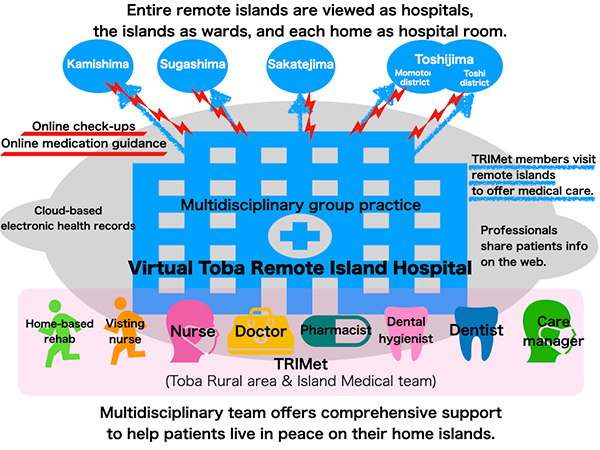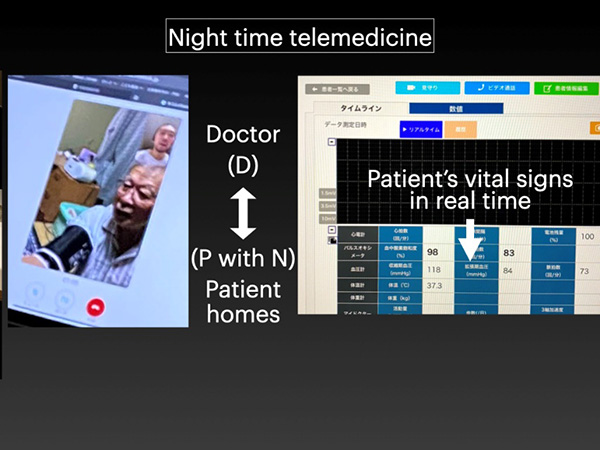Ocean Newsletter
No.508 October 5, 2021
-
Towards the Development of Offshore Wind Power in Japan: The Offshore Wind Industry’s Vision and the Perspectives Necessary for the Public and Private Sectors
TERASAWA Chihiro
Senior Researcher, Sustainability Division, Mitsubishi Research Institute, INC.
Climate change countermeasures are an urgent priority for international community. The large-scale adoption of renewable energy is essential for achieving goals towards decarbonization, and expectations towards offshore wind power are rising in Japan, a country surrounded by the ocean. In this article, I would like to outline the three goals of the “Vision for Offshore Wind Power Industry (1st),” which was announced in December 2020, as well as recommend perspectives that the public and private sectors should hold to realize these goals and accelerate the adoption of offshore wind power.
-
Aiming for a New Type of Medical Care on Remote Islands
KOIZUMI Keigo
Director, Toba City Kamishima Clinic
/ Selected Papers No.27(p.26)
As population decline and population aging continues, the medical care issue of remote islands, where there is an increasing difficulty of permanently placing doctors, is shifting from a problem of “assigning doctors” to “methods of delivering medical care”. In Toba City, Mie Prefecture, medical care on Toba’s remote islands is being conducted virtually thanks to the introduction of a platform which supports remote medical services, a development I consider highly useful. As there are unforeseen situations such as the spread of infectious diseases, I hope that new styles of remote medical care will continue to be provided, allowing residents of remote islands to lead long lives in peace and comfort.
Selected Papers No.27(p.26) -
The Treasures of the Sea Academic Contest: Marine Learning at Hokkaido University
KAWAI Yuji
Vice Dean and Head of Program, Faculty of Fisheries Sciences, Hokkaido UniversitySince 2016, Hokkaido University has been hosting the Treasures of the Sea Academic Contest, the heart of the Marine Learning Event. Presentational works from junior high and high school students all over Japan are put on display; these are based on their personal “Treasures of the Sea” in the two categories of culture and science. Winning works from the first round of selections in 4 different areas nationwide are invited to Hakodate, where the final competition will be held. Through their experience of the various events and the contest, we hope to develop individuals who will shoulder the future of the oceans.
Aiming for a New Form of Medical Care for Remote Islands
As population decline and population aging continues, the medical care issue of remote islands, where there is an increasing difficulty of permanently placing doctors, is shifting from a problem of “assigning doctors” to “methods of delivering medical care”. In Toba City, Mie Prefecture, medical care on Toba’s remote islands is being conducted virtually thanks to the introduction of a platform which supports remote medical services, a development I consider highly useful. As there are unforeseen situations such as the spread of infectious diseases, I hope that new styles of remote medical care will continue to be provided, allowing residents of remote islands to lead long lives in peace and comfort.
Working as Kamishima's Doctor
"Currently, I have come to an isolated island called Kamishima located at the mouth of Ise Bay. It has a population of 1200 to 1300 and around 200 houses. It does not have any trappings of modern society like movie theaters, pachinko parlors, drinking establishments, or coffee shops. Even a person like myself has become immediately purified and started to get up at 6:30 every morning. There seems to be a real human life on this island."
The above is an excerpt from a letter written by Yukio Mishima to Yasunari Kawabata while staying on the island to write his novel, The Sound of Waves. Even today, Kamishima is a place where "real human life," as Mishima put it, lives on. I was so captivated by this island that even after leaving once, I came back to work again. I have now been Kamishima's doctor for a total of 11 years. Kamishima is a small island with a circumference of only about 4 km. It takes about 30 minutes to get there from Toba City in Mie Prefecture, and there are four regular boat services a day. The current population is less than 300, of whom 48.0% are elderly, with almost half of the population being older than 65. There is almost no flat land on Kamishima; it is full of stairs and slopes, making it difficult for the elderly to live there. Nevertheless, the local people enjoy their daily lives. The richness of their lives more than makes up for any inconveniences, something which sparked great envy in me. Since I was assigned to Kamishima, I have provided end-of-life care for several people. Seeing the process in which the islanders watch over the dying gave me an experience I never had before: seeing the warmth of death. It significantly changed my view of life and death as well as my awareness of my work. It was truly beautiful to see. As there are no nursing homes for the elderly on Kamishima, they have to leave the island if it becomes difficult for them to live there. Being born there, being raised there, growing old there, and dying there. Now that realizing this expectation is becoming harder, I think it is my job as Kamishima’s doctor to do my best to meet the wishes of those who want to spend their final days surrounded by fellow residents and to make sure that they can live in this beautiful place for as long as possible.
Telemedicine and Implementing a Group Practice
However, the island's population continues to decline, and excess expenditure due to declining patient numbers cannot be ignored. The same is true for the other remote islands of Toba City. Toba City has four inhabited islands: Toshijima, Sugashima, Kamishima, and Sakatejima. Unfortunately, the population of these outlying islands has decreased by 27% in the past ten years. Furthermore, though there is a system in place to assign one doctor to a clinic on each island, we are just barely able to secure enough doctors through assigning graduates from Jichi Medical University and public recruitment. Therefore, it will likely be challenging to maintain the current medical system, as it will take time to recruit new doctors when vacancies occur. To address the issues of (1) a declining and aging population, (2) a decrease in patients and an increase in excess expenditure at clinics, and (3) difficulties in securing doctors for clinics, we have been considering a system that provides efficient clinic management while maintaining necessary healthcare services. First, after considering geographical conditions, we aimed to shift to a group practice (medical care services provided in coordination with multiple doctors) in which a small number of doctors are in charge of multiple clinics. However, having one doctor in charge of multiple islands means that the medical clinics are not always staffed. In addition, doctors may not be able to come to the remote islands due to unforeseen circumstances such as bad weather or infectious disease outbreaks, in which case residents cannot receive medical care and prescriptions as scheduled.
Given the situation, we thought that by introducing cloud-based electronic medical records and remote medical care as complementary technologies to address the issue, doctors could treat patients from anywhere and alleviate their concerns. Furthermore, in accordance with the revised guidelines for online medical care, if telemedicine is conducted while nurses offer assistance to patients in person (D to P with N), then doctors will be able to order tests and prescriptions, enabling them to provide more appropriate medical care.
We also envisioned that our medical care team, TRIMet (Toba Rural area & Island Medical team), would work in coordination on the basis of treating local residents’ homes as hospital rooms, each island as a hospital ward, and all the remote islands of Toba as a hospital (Virtual Toba Remote Island Hospital). By building a relationship among multiple professions, as if we were working in one hospital, we believed that we could effectively utilize limited human medical resources to provide medical care, nursing care, health issue prevention, and lifestyle support in an integrated manner. Through combining group practice and multi-professional cooperation, we aimed to establish a unique, comprehensive regional care system that is able to respond to medical personnel shortages and the declining population flexibly, while also realizing sustainable remote island medical care that could provide islanders with a safe and secure life on their home islands.
In 2020, the TRIMet Virtual Toba Remote Island Hospital Demonstration Project was adopted as part of the Ministry of Land, Infrastructure, Transport and Tourism's Smart Island Promotion Demonstration Study. As part of the project, we introduced OWEL, a cloud-based electronic medical record system and telemedicine support platform from Secom Medical System Co., Ltd. The introduction of OWEL allows for integrated management of patient information. PCs (electronic medical record terminals) have been installed in seven clinics, including on the mainland, and tablets have been provided for each doctor, enabling patient information to be immediately confirmed and updated even outside clinics.
We have introduced Secom Vitalook as the telemedicine support platform. For example, connecting a blood pressure monitor or other devices to a dedicated tablet terminal enables remote medical treatment through transmitting the patient's vital information (pulse, blood pressure, respiration, body temperature, etc.) to the doctor in real-time, even if a patient is visiting the clinic when the doctor is absent or when a nurse is visiting a patient's home. Through this service, we can now provide almost the same level of medical care remotely even when doctors are not available in person, such as due to bad weather conditions. We no longer run out of regular medications, can respond to patients who have unusual symptoms, and can understand the patient's condition quite precisely even in the event of an emergency. I feel that this significantly reduces anxiety for both doctors and patients.
 How the TRIMet Virtual Toba Remote Island Hospital Works
How the TRIMet Virtual Toba Remote Island Hospital Works  Online medical care in the absence of a doctor on a remote island
Online medical care in the absence of a doctor on a remote island
A New Form of Medical Care for Remote Islands
Populations will continue to decrease, but as long as people live on these islands, we need to provide ongoing medical care. Patients may be sparse, but the scope of medical care must remain the same. As populations decline, the medical care issue of remote islands, where there is an increasing difficulty of permanently placing doctors, is shifting from a problem of “assigning doctors” to “methods of delivering medical care”. More priority should be placed on remote island medical care so that it can receive the benefits of new technologies. We would be grateful if companies with new technologies and ideas could take even a slight interest in the realities we face when providing medical care to remote islands, and work together to address these issues going forward.
In the future, we hope to further develop online medical treatments and medication guidance, home delivery of medications, drones to transport supplies and people, and the use of remote or autonomous ships to transport doctors and patients. My goal is to provide a new form of remote island medical care that combines new technologies with the warmth of these remote islands so that people can live long lives in peace and comfort in familiar environments. I also want the people of these islands to continue to live wonderful lives surrounded by the rich culture and human relationships that exist there, without feeling anxious just because they live on a remote island. (End)
